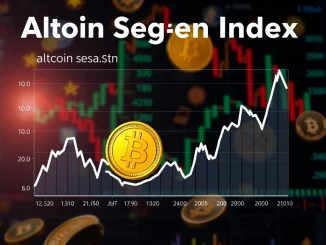
Have you noticed something unusual happening with Bitcoin lately? While the total number of transactions on the network seems to be declining, the cost to send BTC is actually increasing. It’s a head-scratcher for many, and it highlights some interesting dynamics at play within the Bitcoin network.
Understanding the Rise in Average Transaction Fee
According to data from The Block, the seven-day moving average for a Bitcoin transaction fee has climbed to $2.40. This marks a significant point – it’s the highest level recorded so far this year. Compared to the beginning of May, this figure is up by about 1%, showing a steady, albeit small, upward trend in the cost of using the network.
This metric, the average transaction fee, is often seen as a pulse check on network demand relative to block space availability. When demand is high and blocks are full, users typically have to offer higher fees to get their transactions confirmed quickly by miners.
The Puzzle: Higher BTC Fees Amid Fewer Daily Transactions
Here’s where the situation gets particularly interesting, and perhaps counterintuitive. While fees are rising, the volume of activity, measured by the number of daily transactions, has actually decreased quite substantially. The data shows a drop of approximately 35% in daily transactions, falling from a peak of around 507,000 on April 22nd to roughly 330,000 currently.
Typically, you’d expect fees to fall when transaction volume decreases, as there’s less competition for limited block space. The fact that BTC fees are rising while transaction counts are falling suggests other factors are influencing the fee market. What could be causing this divergence?
Why the Disconnect? Exploring Potential Factors
Several possibilities could explain this seemingly contradictory trend:
- Transaction Size and Complexity: The average size or complexity of transactions being sent might be increasing. Larger or more complex transactions consume more block space, potentially driving up fees even if the *number* of transactions is lower.
- Specific Transaction Types: Certain types of transactions that typically pay higher fees might constitute a larger percentage of the remaining transaction volume.
- Mempool Dynamics: While overall daily transactions are down, there might still be periods of congestion or specific blocks getting filled rapidly, leading to temporary fee spikes that push the average up.
- Miner Behavior: Miners prioritize transactions based on the fee offered. If the economics have shifted, miners might be more strictly prioritizing higher-fee transactions, effectively setting a higher floor for fees to get into the next block quickly.
Understanding the exact blend of these factors requires a deeper dive into network data, but the current trend indicates that simply looking at the number of transactions doesn’t tell the whole story about demand for block space on the Bitcoin network.
What Does This Mean for Bitcoin Users?
For anyone sending Bitcoin, especially smaller amounts, rising transaction fees can be a notable challenge. Higher fees reduce the effective amount received and can make micro-transactions less viable on the base layer.
Conversely, for miners, transaction fees represent an increasingly important part of their revenue, especially after halving events reduce the block subsidy. Higher fees contribute to network security by incentivizing mining.
Navigating Higher Fees: Actionable Insights
If you’re concerned about the rising average transaction fee, here are a few tips:
- Check the Mempool: Before sending, check the current state of the transaction mempool (the waiting area for transactions). This gives you an idea of current congestion and suggested fee rates.
- Consider Timing: Network activity fluctuates. Sending transactions during less busy times (often weekends or specific off-peak hours depending on global activity) might result in lower fees.
- Utilize SegWit and Taproot: Ensure your wallet uses modern address formats like SegWit or Taproot, which can make transactions more efficient and potentially cheaper.
- Batch Transactions: If you are a business or individual sending multiple payments, batching them into a single transaction can save significantly on fees.
- Explore Layer 2 Solutions: For frequent or small payments, solutions like the Lightning Network offer near-instant transactions with significantly lower fees, operating on a layer above the main Bitcoin blockchain.
Conclusion: Monitoring the Bitcoin Network Pulse
The current trend of a rising Bitcoin transaction fee alongside a decrease in daily transactions presents an intriguing snapshot of the network’s evolving dynamics. It underscores that the fee market is influenced by more than just simple transaction volume, including factors like transaction complexity and miner economics. While higher fees can pose challenges for users, they also play a crucial role in the long-term security and sustainability of the Bitcoin network. Keeping an eye on these metrics is key to understanding the health and ongoing development of the world’s leading cryptocurrency.



